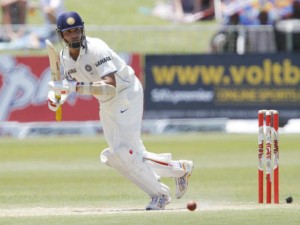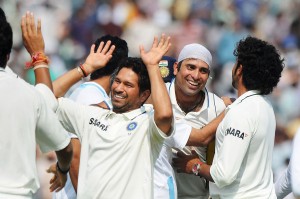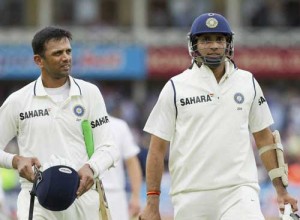2012 is definitely not turning out to be a great year for international cricket. This is because of the retirements which have taken place. Brett Lee, Mark Boucher, Tatenda Taibu are the most recent examples of this. Add VVS Laxman to this list now. He announced his retirement in the same graceful manner as he approaches the game; there was no bitterness but there was pure honesty and humility in his words. He just spoke about the reason of making the decision at this point of time and his journey in national colours a joy which he will never let go off for the rest of his life.
Earlier in the year, India lost Rahul Dravid. Now that Laxman is gone as well, India has lost the most ‘happily married’ couple of the Test team. Dravid and Laxman put up such massive partnerships which devastated opponents. Ask Australia and Steve Waugh in particular! First, it was at the Eden Gardens in Kolkata in March 2001. Australia were on the verge of thrashing India and winning the series comfortably. But John Wright, the then India coach came up with what eventually turned out to be a masterstroke. Laxman was sent in to bat at No.3 instead of the out of sorts Dravid and thus began the massacre of the so-called ‘invincible’ Australian bowling attack. Shane Warne never had the best of times in India and that was not only because of Sachin Tendulkar, but also because of VVS Laxman.
Laxman gave the bowlers such a nightmare that Sourav Ganguly and co., who were already resigned to defeat, suddenly sensed a ‘Very Very Special’ victory against the world champion side. His 281 till date will definitely be remembered as the best Test match innings by an Indian batsman. Mind you, playing in front of a passionate crowd of 100,000 at the Eden Gardens especially when India is on the losing side is not all at all easy. Laxman would have felt the pressure, but he was enjoying his batting now that he had the opportunity to make it regularly into the Indian side, at least in Test matches. When he enjoys his batting, he makes others do so as well and that is beauty of Laxman. This is something which perhaps not many batsmen in the world are capable of doing, but he also lights up Test cricket, which is otherwise a dull and boring format to watch and that too not being very aggressive either.

His most sublime strokes were wristy, which remind many of Mohammad Azharuddin, another celebrated Hyderabadi batsman. On that day, Rahul Dravid, a player of much higher stature then, was inspired by Laxman and also decided to forego his defensive style of batting and torment the Aussies. Laxman was dead exhausted with his 281, but alongside Dravid’s 180, he ensured that India were very much in the contest and an ‘upset’ win was on the cards. India did eventually win by 171 wins, courtesy Harbhajan Singh’s 6 wicket haul in the second innings but anyone would give almost the entire credit to Laxman for this victory.
With that performance, Laxman not only made a name for himself but also saved the jobs of Sourav Ganguly as captain and John Wright as coach. From there on, Ganguly and Wright went on to form one of the finest captain-coach partnerships in Indian cricket and sowed the seeds of India’s 2011 World Cup victory by bringing in an aggressive attitude in the dressing room when it comes to mental as well as physical fitness. If India reached the No.1 ranking in both Test and ODI cricket in 2009, it is because of players such as Virender Sehwag, Zaheer Khan, Harbhajan Singh and Yuvraj Singh all of whom Ganguly and Wright nurtured at the dawn of their careers.
The implications of that huge contribution of Laxman were more than just this. Rahul Dravid also made a return to form due to Laxman being the ideal partner for him at the crease, and eventually he, Dravid, Tendulkar and Ganguly made the ‘Fab Four’ of Indian cricket. India were considered by their opponents as the most dangerous batting line up in the world and thus they began to win more away from home as well. Today, India is one of the best teams in the world in all formats of the game and no team can consider them pushovers, even if they are not in the best of forms.
But before Kolkata 2001, things did not look rosy for Laxman to make it big for India. Coming from a medical family, there was parental pressure to a little extent of him having to become a doctor or a medical practitioner. But he had to struggle with that as well as competition in domestic cricket. As things worked out though, he made his international debut in a Test match against South Africa at Ahmedabad in 1996 on what was a horrendous pitch to bat on. Yet, Laxman was patient enough for his 62 in the second innings as India won the game by 64 runs. There was promise shown, but not for too long.

He was shabbily treated for being one of the babies of the team. For example, he did not know where exactly he had to bat, because in one series he was asked to open and in the next, asked to bat in the middle order. That affected his form to a huge extent, and as a result he was in and out of the Indian team on a frequent basis. Although he continued to accumulate tons of runs in domestic cricket in which he was literally considered the King of all batsmen, international cricket was unfortunately not that friendly to him.
The first signs of genius came in the New Year’s Test in Sydney in January 2000. That is because his first Test hundred was against Steve Waugh’s Australia in that game. It was a counterattacking 169, which could be thought of as a prelude to the more majestic 281 in Kolkata. India lost the match and the 3 match series, 0-3 since Laxman virtually had no support at the other end, but his love affair for the Australian attack began from that game. Such was the quality of that innings that Sachin Tendulkar, the then India captain gifted him an expensive pair of the stylish Oakley’s sunglasses.
But it was after the Kolkata marathon that Laxman was a certainty for India. Competition was there with the likes of Virender Sehwag, Dinesh Mongia, and Yuvraj Singh also in contention for that No.6 spot but Laxman managed to clinch it successfully, as Sehwag made it later to the team as a regular. The next time India toured Australia was in the end of 2003, and he teamed up with Dravid again in a precarious situation to turn the tables around and guide India to the winning post. This time however, he had to let Dravid play the lead actor while he had to play the supporting role to him. Dravid batted hours and hours for his 233, but many were happy to see more of Laxman on strike with Dravid because it was a rarity to see any Indian batsman apart from Sachin Tendulkar to thrash the Aussies in their own conditions. The Wall’s scientific style of batting blended perfectly with the ‘Very Very Special’ Laxman’s artistic style of batting. From 85 for 4, India finished with a total of above 500, giving the hosts a slender lead of 30 runs.
Laxman’s 148 proved to be extremely crucial as like Harbhajan Singh, Ajit Agarkar took 6 Australian wickets in the second innings and set India a target of 230 to win. Dravid played another fine hand, as India won by 4 wickets in that second Test match at Adelaide and took the series lead 1-0. The series was eventually drawn 1-1, but the win was India’s first since the 1970s and proved that Australia could be beatable even in their own conditions, no matter if they did not field McGrath and Warne. The Hyderabadi’s second hundred of the series was again in Sydney (a la 1999!), which was even a better effort than Adelaide. His 179 ensured that Australia do not win and give one of his idols, Steve Waugh a very happy farewell.
As his career went on, Australia had to acknowledge Laxman and not Tendulkar as their ‘Enemy No.1’. The 281 was a once in a lifetime knock, but he did play impressive innings against them. His 70 against Australia in Mumbai in the inconsequential final Test of the series in 2004 on a horror pitch comes into mind, which was uncannily similar to his debut knock against South Africa in 1996. India won the game by 13 runs, and lost the series with some pride. Losing 1-2 is better than losing 0-3 at home, for sure!
His 79 in the second innings at Perth in 2007, helped India beat Australia for the first time at the venue which is considered as ‘Australia’s den’. The win made other teams such as South Africa, perhaps believe that they could do the same as India and they actually did it the following year. India lost the series 1-2, but the loss in Sydney was very controversial due to racial abuses and poor umpiring decisions. However, Laxman was one of the standout performers in the match with his 109 in the first innings. His romance with Sydney will always go down as evergreen, just as Shahrukh Khan’s romance with Kajol in the 90s!

But coming back to Laxman, he took full advantage of Australia’s weakened bowling attack in the 2008 and 2010 Border Gavaskar Trophy series at home. The second double hundred of his career also came against Australia, and that was in the third Test match of the 2008 series at the Feroz Shah Kotla in Delhi. And then of course fast forwarding 2 years, his 75 in the second innings in the first Test in Mohali was remarkable considering that India was 124/8 in the chase of 210 and Laxman was constantly troubled by back spasms in that sweltering heat. Ishant Sharma played his part exceedingly well with his valuable 30 odd runs but Laxman was undoubtedly the anchor of that successful chase. India went to whitewash Australia for the first time in a Test series of more than one match, winning 2-0.
Laxman is only the second man after Tendulkar to score 2000 runs against Australia in Test cricket, a phenomenal achievement indeed. No wonder then that it is fitting for him to have played the final Test of his career against his favourite opposition in Adelaide last year. Many believe though, that he was not a great success against other teams which undermines his greatness. It is not true to a huge extent.
Agreed that 6 out of his 17 Test centuries have been scored against Australia, but 4 of them have also come against West Indies. Out of these 4, 2 came away from home in 2002 and 2006 whereas the other 2 were co incidentally in Kolkata in the 2002 and the 2011 series against the opposition. A hundred is a hundred at the end of the day and Laxman deserves the credit for it. He loved Kolkata as much as he loved Sydney, and a proof of this is his two more hundreds there. One against Pakistan at Kolkata in November 2007 and the other against South Africa in 2010, which was significant in helping India maintain their World No.1 ranking in Test cricket as India had to win the match to prevent South Africa from replacing them at the top. Alongside Mohammad Azharuddin, another of his childhood idols, he is one of the few batsmen in the world to have soaked up the pressure of the Eden Gardens very well.
His other away centuries were against Zimbabwe in 2004 and Sri Lanka in 2010. The knock against Sri Lanka was a match winning one and a series levelling one as well, since India had lost their top order in the chase of 260. Yet Laxman despite not being 100% fit, guided his team home. But one of the biggest criticisms that he has faced is his inconsistency, which has not allowed him to put up big scores on the board. Yes, he has failed miserably against oppositions such as England, Pakistan and South Africa especially in those countries.
I think that Laxman is that sort of a player who has to be judged more qualitatively rather than quantitatively. He has scored as many as 56 half centuries in 225 innings, which simply put means that he has scored one half century in every four innings. This is an outstanding figure indeed! He has played always for the team’s cause, despite the team not making him bat up the order. It has to be taken into account that he usually has batted either at No.5 or No.6, which is a position where batsmen are forced to bat alongside tailenders or lower order batsmen. This does not give him a great probability of scoring big knocks and thus his 30s, 40s or 50s for instance have to be appreciated.

Dravid and Tendulkar by far are better than Laxman when it comes to skill which is why they bat higher in the batting order, but Laxman has surely been India’s ‘crisis man’ in Test cricket more than often not in comparison to those two. Take his knocks against Australia and Sri Lanka which I mentioned above, into consideration. He played a very critical hand in helping India win a Test in Durban against South Africa in 2010, with his 96 in the second innings on what was a deteriorating pitch and having to face a bowling attack comprising of Dale Steyn and Morne Morkel.
Another memorable fifty of his was his 67 not out against New Zealand at Mohali in 2003. India collapsed to 424 in the first innings, in reply to the Kiwis 630. Even though the pitch was a good batting strip, India were on the verge of a rare and embarrassing home series defeat, that also in the hands of New Zealand. But he faced as many as 183 balls for his 67, and finished with an aggregate of 171 runs in the match as India managed to draw the game and the series ended in a stalemate. There are many such fifties which Laxman has scored, and they usually have been in the situation of adversity. What will this Indian team under Dhoni do without Laxman? Considering that all this happened with a much stronger team in the past.
However, Laxman has truly failed in not being a better limited overs player. He has scored only 6 hundreds in ODI cricket and 4 of them have come against the Kangaroos. A strike rate of 72 does not make him worthy of this format of the game and thus he could not make it to any of the World Cup squads in 1999, 2003, 2007 and 2011. His inability to adapt to scoring at a much faster rate will just make a good player in the history of Indian cricket, but not great. But then I guess every cricketer’s career is not perfect, and so Laxman must be respected for whatever he has been able to achieve and through that, make India proud.
Since his childhood, it is ironic that he has idolised Australia’s style of playing, when the truth is that Australia is his favourite punching bag and the fact that he never shows his aggression on the field (whether it comes to batting or fielding). In a world of arrogance and cut-throat competition in which players can go to any extent to achieve what they wish to, Laxman just goes about doing his business being quiet and humble. Like Dravid, Laxman too is a team player who puts his aspirations secondary to that of the team and thus he is one of the most respected figures of Indian cricket at the moment. In order to give youngsters a chance, he decided to call it quits before the Test series against New Zealand begins. If he had his way, he could have played both the Tests or at least the first Test in Hyderabad, his hometown and retired after the game got over which would have made it like a ‘Farewell’ Test.
Laxman’s retirement was not handled well at all by the Indian selectors. There should have been a detailed talk from before with him about the issue and then they could have acted. The plan perhaps would have been to forcefully ask him to resign after the Test series, with the performances not been given that much of weightage. But Laxman decided to quit on his own, therefore saving himself from such humiliation. Agreed that he did not have a great outing in England or Australia last season, but this is not the way to treat a player who has given so much to Indian cricket with his graceful character and batting ability.
He will be remembered as the ‘Test specialist’ and with Dravid and Ganguly retiring long ago, India will have a new look batting line up even with Sachin Tendulkar present in it. If Australia were the butt of jokes because of their performances after the retirements of Langer, Hayden and Gilchrist for example, India could also be because their transition phase is about to begin. Laxman is almost irreplaceable in the longest format of the game and these days, hardly any Indian batsman has fine temperament. It remains to be seen whether India continue to be a dominant force at home and regain their ability to win away from home now that the ‘Very Very Special’ man is gone.






Leave a Reply